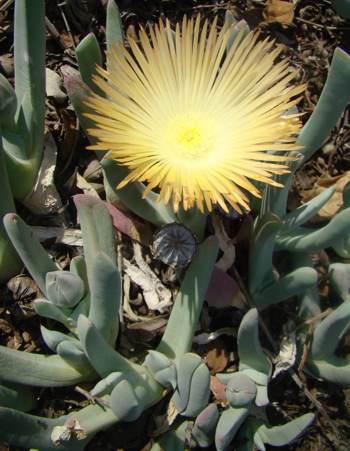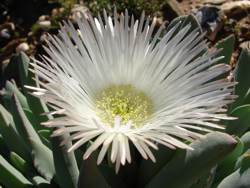Cheiridopsis denticulata
Cheiridopsis denticulata (Haw.) N.E.Br.
Family: Aizoaceae
Common names: t'noutsiama (Nama)
Introduction
Oh, it's flowering time: it's really awesome to see what mesembs look like when blooming in their natural habitat.

Description
Description
Cheiridopsis denticulata is a small, perennial, spreading succulent plant that grows in the arid western part of the Northern Cape, i.e. Namaqualand and the Richtersveld. The leaves are opposite with one or two, sometimes three, erect pairs of leaves on many ground-level branches. Often the leaf pairs are dissimilar or unequal and connate (fused) in various ways. The leaves are grey-blue with a slightly wrinkled surface, more so in dry conditions. They are triangular in cross section and the keel tapers to the inside with a tiny spine at the tip. The flowers have four or five sepals and many stamens. The petals are numerous and usually yellow, orange or white, occasionally violet to red in colour.

The capsule is 8- to 19-locular with pyriform-triangular (pear-shaped-triangular), whitish to brownish seeds.

Conservation Status
Status
The current conservation status of Cheiridopsis denticulata is listed as LC (Least Concern) (Raimondo et al. 2009), and the species is therefore not threatened.
Distribution and habitat
Distribution description
The distribution range of Cheiridopsis denticulata covers a broad band spreading from Lüderitz, in Namibia, southwards through the Richtersveld and Namaqualand in the Northern Cape Province, to the northern parts of the Western Cape Province, in South Africa. The largest concentration of the species is in the vicinity of Stinkpot and Platbakkies in Namaqualand. Winter rainfall predominates across the entire distribution area.
Derivation of name and historical aspects
History
The generic name Cheiridopsis comes from the Greek words cheiris, meaning sheath, and opsis, look or appearance, referring to the white dry base of the leaves which covers and protects the young exposed green leaves like a sheath.
Ecology
Ecology
The flowers open during the afternoon and are pollinated by bees.
The plants go dormant in summer but do not die back to rootstock. They become more compact, the older leaves withering forming a protective sheeth at the base (Cheires=sleeve) and the new leaves emerging but remaining compact, waiting for the rain when they grow again. In other words they recyle their moisture from the older to the younger leaf pair, but do not become deciduous (pers comm. Ernst van Jaarsveld).
. 
Uses
Use
The only recorded use of the plant is in the horticultural trade.
Growing Cheiridopsis denticulata
Grow
Cheiridopsis denticulata can be grown easily from seeds. Sow seeds in autumn, and, to improve the chances of germination, place the seeds in a small container with warm water for 24 hours. This will help to soften the hard outer layer of the seeds. Sow the seeds in a sandy medium and cover them with a thin layer of fine sand about 1 mm thick. Keep them damp, using a fine spray, until seeds start to germinate in about seven to fourteen days. Once the seedlings start growing, slowly reduce the amount of water.
C. denticulata normally grows in small, almost pure stands. It is characteristic of Namaqualand, which lies in the winter-rainfall region with hot, dry summers. It needs little water but responds well to regular watering in autumn to winter. It also needs a sandy, well-drained soil that is rich in minerals. Watering should be minimal in summer, but plants can be sprayed with a fine mist from time to time. They do well when grown in conditions similar to those in their natural habitat or in a greenhouse.
References
- Barkhuizen, B.P. 1978. Succulents of Southern Africa. Purnell, Cape Town.
- Burgoyne, P.M. 2006. Cheiridopsis denticulata (Haw.) N.E.Br. National Assessment: Red List of South African Plants version 2013.1. Accessed on 2013/03/07.
- Hartmann, H.E.K. 1998. Growth forms and leaves in the genus Cheiridopsis N. E. Br. Cactus & Succulent Journal (U.S.) 60: 168-173.
- Le Roux, A. & Schelpe, E.A.C.L.E. 1997. Namaqualand . South African Wild Flower Guide 1. Botanical Society of SouthAfrica, Cape Town.
- Raimondo, D., Von Staden, L., Foden, W., Victor, J.E., Helme, N.A., Turner, R.C., Kamundi, D.A. & Manyama, P.A. 2009. Red List of South African Plants 2009. Strelitzia 25. South African National Biodiversity Institute, Pretoria.
Credits
Stemmer Ngalo
Free State National Botanical Garden
April 2013
Plant Attributes:
Plant Type: Succulent
SA Distribution: Northern Cape, Western Cape
Soil type: Sandy
Flowering season: Winter
PH: Neutral
Flower colour: Purple, Red, White, Pink, Cream, Yellow, Orange
Aspect: Full Sun
Gardening skill: Easy
Special Features:
Horticultural zones









Rate this article
Article well written and informative
Rate this plant
Is this an interesting plant?
Login to add your Comment
Back to topNot registered yet? Click here to register.